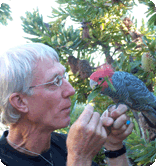Flock behavior and Hawk-headed Parrots

Hi EB, A while ago, you asked if my Hawkheaded parrot is OK sharing the indoor sunroom with our 6 other companion parrots. In this room we have 3 amazons, a galah, a vos eclectus, and our Alexandrine, Hedda Pearl, who has survived many strokes but shows the signs of her illness. She is otherwise abled.
Hawkeye is pretty good about being out in the room with everyone else out, too, but that situation can change in a flash, so she’s only out when I’m home and attentive. EB, of all people, you know how wonderfully tuned-in these birds are, so please let me know how you’d handle. I’d love it if Hawkeye could be out 24/7 in this specially-designed-for-them room, but if, say, a hawk flies overhead or there is another disturbance, Hawkeye takes off and generally, she flies to Hedda’s cage. There Hedda quakes because she’s seen/heard the scary thing, too, then she flaps in the non-rhythmic way of a stroke survivor, and Hawkeye flares.
When I get there—because I am being attentive—they both settle down; how quickly depends on whether or not the situation escalates.
So, can you hear and envision the bird room? The Amazons are all yelling their war cries, Hawkeye’s war bonnet is fully flared, Hedda is going crooked, Nikki and Cella are trying to stay out of the way. Hawkeye will always come to me, of course, so that’s good. But still, when it happens, I’m always glad I’m close by.
So, it’s a situation I invite only with supervision. Hawkeye is strong, Hedda is brave; accidents can be avoided, yes?
In your experience, any techniques to keep Hawkheads steady in a flock?
Thanks,
Phoebe

Hi Phoebe, Answering flock behavioral questions is, as always from afar, a bit touchy. It sounds like you have a somewhat stable situation with the seven birds in your bird room; and given the supervision they all get, it is working adequately.
More to the point, how would I set parameters to provide the hawk-head with unlimited time out of it’s cage? Frankly, I see no way….
If my years with hawk-headed parrots taught me one thing, it was that these birds are extremely unpredictable. You have the good fortune to be keeping a single female instead of a male, which alleviates some of the aggression, but, basically once a hawk-head of either gender becomes mature, he or she becomes the most dominant psittacine in any room full of similar sized birds. Our former pets and breeders (we no longer keep hawk-headed parrots) were high strung and unsettling to our other parrots. They would attack and bite on slight provocation any intruder they perceived as a threat or rival—dogs, cats, humans included. A case in point was our male hand-fed, Chen, who would take a nut from April’s hand, then a minute later, attack her hair and viciously bite the back of her neck if she was not wary.
Add to this the fact that you have an unwell parrot in the room with Hawkeye and it becomes doubly dangerous. Certain aggressive hookbills are agitated and prone to attack birds that are behaving erratically as stroke victims, begging hens of parakeet species, wet birds after a bath, etc.
I would surmise that Hawkeye grew up as a baby handfed with some of the birds in the birdroom already in your home, and that helps the environment by eliminating the “new intruder” concept, but nevertheless, I would hardly risk it to leave Hawkeye out unsupervised—-to my way of thinking, it is a bit like keeping a pet chihuahua who has always been “good around the birds.”
Besides, hawk-heads are most predictable around other hawk-heads and the way that they have been observed in the wilds suggests they are not at all the social type of pet most parrot lovers envision when they see the helpless little fledgling at the pet store. Hawkeye might be happiest getting “away” from the bird room for out-of-cage stimulation in an outdoor flight or garden greenhouse—that also might give the other six parrots a break too, as living with a hawkhead a few feet away can truly up the tension level in any mixed flock.
Good luck and keep up the great work
EB

































